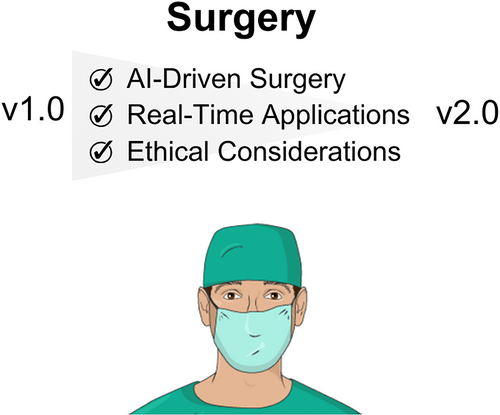The roadblocks to AI adoption in surgery: Data, real-time applications and ethics
Graphical Abstract
This paper explores the critical barriers to AI integration in surgery, focusing on challenges in data management, real-time application and ethics. It emphasizes the need for robust data-sharing frameworks, advancements in real-time processing capabilities and ethical guidelines to ensure responsible AI deployment.
Abbreviations
-
- AI
-
- artificial intelligence
-
- RT
-
- real-time
1 INTRODUCTION
Artificial intelligence (AI) has emerged as a transformative force in medicine, offering unprecedented opportunities to revolutionize various aspects of healthcare. In particular, AI has the potential to significantly enhance surgeons' capabilities by leveraging advanced data analytics and sophisticated decision-making tools [1]. The true promise of AI in surgical practice lies in its remarkable ability to process vast and complex datasets in real-time (RT), thereby providing surgeons with actionable insights that have the potential to improve patient outcomes markedly. Nevertheless, the journey toward the full integration of AI into surgical practice is laden with numerous challenges that must be meticulously and systematically addressed. This commentary delves into these challenges, emphasizing the critical areas of data acquisition, the feasibility of RT applications and the ethical considerations that arise. Each aspect is pivotal to AI's successful and responsible implementation in surgical environments, where the stakes are high, and the potential for impact is profound.
2 DATA CHALLENGES IN AI-DRIVEN SURGERY
The foundation of any effective AI system is the availability of high-quality, annotated data. In the surgical domain, this requirement presents significant challenges. Surgical procedures generate vast amounts of data, particularly video recordings and imaging, essential for training AI models, where 1 min of surgical video is estimated to contain 25 times the amount of data found in computed tomography imaging [2]. However, the variability in surgical techniques, patient anatomy and the inconsistent use of data collection methods across different institutions create substantial hurdles in building comprehensive datasets that are both diverse and standardized. A further challenge in this context is that data annotation in surgery is time-consuming and highly specialized, requiring expert surgeons to label critical anatomical structures, surgical steps and potential outcomes. This labor-intensive process significantly limits the scale of datasets that can be used for training AI models. Moreover, there is a general reluctance among surgeons to record and share surgical data, primarily due to concerns over patient privacy and the potential legal implications of such recordings. This hesitancy limits the amount of data available for AI model training, resulting in models that may lack the robustness and generalizability needed for widespread clinical use. To address these data challenges, it is critical to foster collaboration between institutions to create standardized data-sharing frameworks. Standardized data collection and annotation methods across healthcare systems would significantly improve AI training. Furthermore, incentives should be created to encourage sharing of surgical data while ensuring stringent patient privacy protections through ethical and legal safeguards. Blockchain technology could also be explored to share data across institutions while maintaining privacy securely. Furthermore, the variability in the quality of the collected data further complicates the training process, as AI models require consistent and high-quality inputs to produce reliable outputs. To address these challenges, there is a need to develop standardized protocols for data collection and annotation, ensuring that data from different sources can be seamlessly integrated into AI systems. For instance, Meireles et al. [3] have proposed an established hierarchy for annotating temporal events in surgery, comprising temporal models, actions and tasks, tissue characteristics and general anatomy and software and data structure. Incentives should be provided to encourage the recording and sharing of surgical data, with strong safeguards in place to protect patient privacy and confidentiality. Research is being conducted into semi-automated and AI-assisted annotation tools, which could help reduce the time surgeons spend on data labeling and increase the scalability of annotated datasets. These solutions are still in the early stages and require further development and validation to be implemented effectively. While the paper focuses on challenges, it is worth mentioning that successful AI implementations have already been seen in fields like robotic surgery, where AI-assisted systems have shown the potential to improve surgical precision and reduce complication rates. These developments can serve as examples of how AI can overcome these challenges and be successfully integrated into surgical practices. By enhancing the quality and availability of surgical data, AI systems can be trained to a higher standard, ultimately improving their reliability and effectiveness in clinical settings.
3 REAL-TIME APPLICATIONS: FEASIBILITY AND LIMITATIONS
One of AI's most promising applications in surgery is its potential to provide RT decision support during procedures. By analyzing data as it is generated, AI systems could assist surgeons by identifying critical anatomical structures, predicting potential complications and guiding surgical actions with precision. As an example, Madani et al. [4] evaluated an AI-driven model to distinguish between safe and hazardous dissection areas, while also recognizing anatomical landmarks during laparoscopic cholecystectomy. The study demonstrated an overall accuracy of 94% and 83% for detecting safe and unsafe zones, respectively.
However, several technical and operational challenges currently limit the feasibility of such RT applications. RT AI applications in surgery demand high computational power and the ability to process and interpret data instantaneously. The latency in data processing poses a significant barrier, as even slight delays can render AI assistance less useful or, in some cases, potentially harmful. Current research is making strides in this area, with new prototypes and AI models being tested in RT surgical guidance. For instance, AI-driven robotic surgery systems such as those used in prostatectomies have demonstrated improved precision in identifying critical structures like nerve bundles. One of the primary contributors to this latency is the complexity of AI algorithms. These algorithms often require optimization to improve their processing speed and ability to handle large-scale, high-dimensional data without compromising accuracy. Additionally, integrating AI tools into the fast-paced and dynamic operating room environment requires careful consideration of workflow compatibility, ensuring that these tools enhance rather than disrupt the surgical process. Advancements in computational technologies are necessary to reduce latency and improve the speed and accuracy of RT AI applications. Algorithmic optimization techniques, such as model pruning and quantization, are being explored to enhance processing efficiency and minimize the computational load, which could lead to faster RT applications in surgery. Collaborative efforts between AI developers and surgical practitioners are also crucial to tailor these technologies to the specific needs of the surgical environment. The success of current implementations like RT AI in robotic-assisted surgeries highlights the progress already being made, demonstrating that these challenges, while significant, are being addressed by current research and development efforts. By addressing these feasibility issues, AI's potential to provide RT surgery support can be fully realized, offering significant improvements in surgical precision and patient safety.
4 ETHICAL CONSIDERATIONS IN THE DEPLOYMENT OF AI IN SURGERY
Integrating AI into surgical practice brings a host of ethical considerations that must be carefully navigated. Data privacy, algorithmic bias and accountability issues become paramount in clinical decision-making. Data privacy is critical, particularly as AI systems often require access to large amounts of sensitive patient information, thus being interesting assets for prevalent cyberattacks. Data suggest that 1 out of 4 cyberattacks were in the healthcare industry [5], while 90% of hospitals and clinics experienced at least one data breach, and 45% experienced at least five data breaches [6]. Ensuring that patient data is handled with the utmost confidentiality is essential to comply with legal requirements and maintain public trust in AI technologies. Moreover, the potential for bias in AI algorithms, stemming from unrepresentative or incomplete training data, poses a risk of exacerbating disparities in healthcare outcomes [7]. AI systems must be developed and trained using diverse and representative datasets to minimize bias and ensure equitable treatment across different patient populations. Addressing these ethical challenges requires an interdisciplinary approach, involving not only AI researchers and surgeons but also ethicists, policymakers and legal experts. Collaborative frameworks between these groups are essential to ensure that AI technologies are deployed responsibly in the surgical field. Accountability is another significant ethical issue, particularly when AI-driven decisions lead to adverse outcomes. Establishing clear lines of responsibility between the AI system, the surgeon, and the technology developers is crucial to ensure that accountability is maintained for errors or complications. Developing robust legal and ethical frameworks to address these issues is necessary to guide the responsible deployment of AI in surgery.
5 ECONOMIC, OPERATIONAL AND TRAINING IMPACTS OF AI ADOPTION IN SURGERY
The adoption of AI in surgery has the potential to bring significant economic benefits, mainly through cost reductions associated with improved surgical precision, shorter hospital stays and fewer post-operative complications. However, the initial costs of AI implementation can be substantial, including investments in AI technologies, infrastructure and training programs for surgeons and healthcare staff. A balanced analysis of these costs versus the long-term benefits is essential. Several studies indicate that once integrated, AI-driven systems can increase the efficiency of surgical procedures, ultimately leading to reduced healthcare costs over time [8, 9]. As AI becomes more prevalent, the operational dynamics within surgical teams are also likely to change. AI systems may alter the traditional decision-making process, particularly when AI-generated insights challenge the surgeon's intuition or experience. Establishing clear protocols for incorporating AI recommendations into surgical practice will be essential to ensure that team communication and patient safety are not compromised. The evolving role of AI in the operating room may also influence the hierarchy within surgical teams, requiring adjustments in how team members interact with AI-driven systems and how they interpret AI outputs in the context of patient care. Furthermore, the growing integration of AI implies changes in how surgeons are trained. Future surgeons will need to master traditional surgical techniques and AI systems in clinical practice. This shift requires incorporating AI-related content into medical curricula, focusing on how to interpret and apply AI-generated insights during surgery. Simulation-based training programs incorporating AI tools could offer surgeons hands-on experience, allowing them to practice using AI systems in a controlled environment. Continuous professional development programs will also be vital as AI technologies evolve, ensuring surgeons stay up-to-date with the latest advancements and best practices for AI-assisted surgery. By providing comprehensive training and support, surgical teams can fully harness the benefits of AI while maintaining patient safety and high standards of care.
6 CONCLUSION
The promise of AI in surgery is immense. It offers the potential to enhance surgical precision, improve patient outcomes and transform the field of surgery. However, realizing this potential requires overcoming significant challenges related to data acquisition, RT application and ethical considerations. By addressing these challenges head-on, the medical community can pave the way for the successful integration of AI into surgical practice, ensuring that these technologies are used responsibly and effectively to improve patient care.
AUTHOR CONTRIBUTIONS
Tiago Cunha Reis: Conceptualization (lead); data curation (lead); formal analysis (lead); funding acquisition (lead); investigation (lead); methodology (lead); project administration (lead).
ACKNOWLEDGMENTS
None.
CONFLICT OF INTEREST STATEMENT
The author declares no conflict of interest.
ETHICS STATEMENT
Not applicable.
INFORMED CONSENT
Not applicable.
Open Research
DATA AVAILABILITY STATEMENT
Data sharing is not applicable to this article as no data sets were generated or analyzed during the current study.





